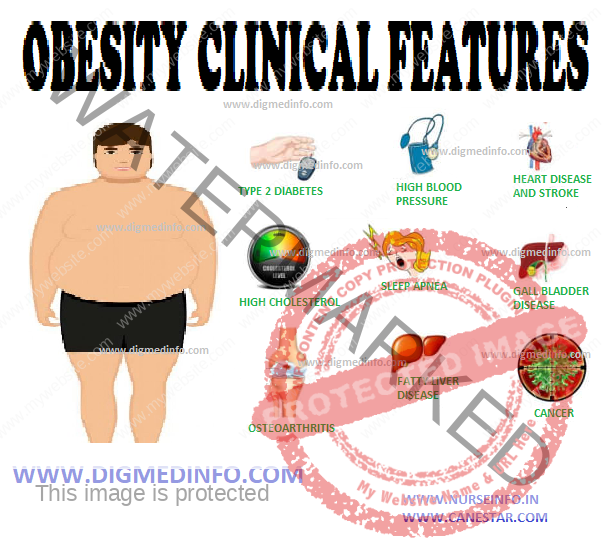OBESITY – CLINICAL FEATURES, COURSE AND PROGNOSIS and DIAGNOSIS
CLINICAL FEATURES
Middle-aged persons are more affected though no age is immune. Women outnumber men and the male to female ratio is 1:5. Multiparity is associated with increasing grades of obesity. The patient may not complain of her obesity on account of its gradual development and, therefore, it has to be identified during general examination. Common symptoms include exertional dyspnea, sluggishness, angina, arthralgias of knees and hips, or any of the complications.
Complications
These develop invariably in all cases depending on the severity and duration of the disorder.
1. Ill effects of increased weight: Slowness of movement, proneness to falls and accidents, osteoarthritis of weight-bearing joints like knees, hips, and spine.
2. Skin: Abnormal skin folds develop and these give rise to fungal infection (moniliasis), recurrent bacterial infections, and chafing of the skin of the thighs and axillae. In extreme obesity, striae may develop.
3. Cardiovascular system: Atherosclerosis, hypercholesterolemia, angina, ischemic heart disease, hypertension, varicose veins, venous thrombosis, and recurrent embolism. Increase of 10% of weight above the ideal weight leads to 30% rise in the risk of heart disease.
4. Respiratory system: Exertional dyspnea, reduction in vital capacity due to restriction of diaphragmatic movements and the increased mechanical effort required to move the thoracic cage, recurrent bronchitis, and in extreme cases, respiratory failure. ‘Pickwickian syndrome’ is the condition where obesity is associated with central depression of respiration and somnolence. Sleep apnea and the related complications are more common in them.
5. Abdomen: The skin over the anterior abdominal wall hangs down as a fold (“abdominal apron”). Hernias develop owing to the increase in the intra-abdominal pressure. Gallbladder lesions are more common.
6. Metabolic complications: Diabetes mellitus, hyperlipidemias, gout, and cholesterol gallstones are more common.
7. Psychological abnormalities: Obese persons may develop depression because of their unattractive physical appearance and mechanical disability. They tend to avoid company and become socially isolated.
8. There is evidence that cancer of the colon, breast, uterus, ovaries and prostate may be more common in the obese.
COURSE AND PROGNOSIS
The condition is gradual in its progress. Complications increase the mortality in them. Mortality rate is 30% higher in persons 25-30% overweight and 50% higher in persons 35-40% overweight. Death is caused by cardiovascular, metabolic or respiratory complications. Obesity is an independent risk factor for higher mortality.
DIAGNOSIS
Clinical diagnosis is based on weight, physical appearance and measurement of skin fold thickness. Sophisticated methods are available to establish the diagnosis in a borderline case. Dual energy X-ray absorptiometry (DEXA) imaging gives a reliable assessment of the
adipose tissue mass. Increase in weight occurring during pregnancy, fluid retention, hypothyroidism, hypothalamic lesions, and other endocrine disturbances should be differentiated from obesity due to nutritional causes. So also overweight may be caused by excessive muscular development in wrestlers, weight-lifters and boxers. Estimation of BMI, and the waist to hip ratio help to assess the risk of complications further. The aim of management is to reduce weight, achieve metabolic and physical fitness, reduce morbidity and achieve cosmetic results. A negative balance of 8000-9000 calories has to be achieved to clear 1 kg of adipose tissue.


